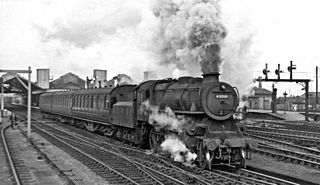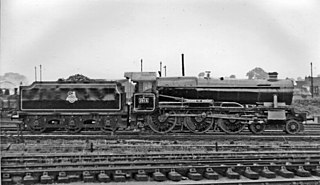Robert Arthur "Robin" Riddles, CBE, MIMechE, MinstLE was a British locomotive design engineer.

70013 Oliver Cromwell is a British Railways Standard Class 7 preserved steam locomotive. The locomotive is notable as one of the four steam locomotives which worked the last steam railtour on British Railways (BR) in 1968.

The British Railways Standard Class 9F2-10-0 is a class of steam locomotive designed for British Railways by Robert Riddles. The Class 9F was the last in a series of standardised locomotive classes designed for British Railways during the 1950s, and was intended for use on fast, heavy freight trains over long distances. It was one of the most powerful steam locomotive types ever built for British Railways, and successfully performed its intended duties. The 9F class was given the nickname of 'Spaceship', due to its size and shape.

The steam locomotives of British Railways were used by British Railways over the period 1948–1968. The vast majority of these were inherited from its four constituent companies, the "Big Four".

The BR Standard Class 8 was a class of a single 4-6-2 Pacific steam locomotive designed by Robert Riddles for use by British Railways. Only the prototype was constructed, which was christened the name Duke of Gloucester. Constructed at Crewe Works in 1954, the Duke, as it is popularly known, was a replacement for the destroyed LMS Princess Royal Class locomotive number 46202 Princess Anne, which was involved in the Harrow and Wealdstone rail crash of 1952.

George Jackson Churchward was an English railway engineer, and was chief mechanical engineer of the Great Western Railway (GWR) in the United Kingdom from 1902 to 1922.
The London and North Eastern Railway (LNER) produced several classes of locomotive, mostly to the designs of Nigel Gresley, characterised by a three-cylinder layout with a parallel boiler and round-topped firebox. It produced the most famous locomotive of its day, 4468 'Mallard', the holder of the world steam locomotive speed record. It also built the world-famous 4472 'Flying Scotsman'. However, its locomotive inheritance was much greater than just the 'A4 Class', it also produced highly successful mixed-traffic and freight designs.

BR Standard Class 9F number 92220 Evening Star is a preserved British steam locomotive completed in 1960. It was the last steam locomotive to be built by British Railways. It was the only British main line steam locomotive earmarked for preservation from the date of construction. It was the 999th locomotive of the whole British Railways Standard range.

The BR Standard Class 6, otherwise known as the Clan Class, was a class of 4-6-2 Pacific tender steam locomotive designed by Robert Riddles for use by British Railways. Ten locomotives were constructed between 1951 and 1952, with a further 15 planned for construction. However, due to acute steel shortages in Britain, the order was continually postponed until it was finally cancelled on the publication of the 1955 Modernisation Plan for the re-equipment of British Railways. All of the original locomotives were scrapped, but a new one is being built.

The BR Standard Class 7, otherwise known as the Britannia Class, is a class of 4-6-2 Pacific steam locomotive designed under Robert Riddles for use by British Railways for mixed-traffic duties. 55 were constructed between 1951 and 1954. The design employed results from the 1948 locomotive exchanges undertaken in advance of further locomotive classes being constructed. Three batches were constructed at Crewe Works, before the publication of the 1955 Modernisation Plan.
Roland Curling Bond was a British locomotive engineer.

The LMS Ivatt Class 4 2-6-0 is a class of steam locomotive primarily designed for medium freight work but also widely used on secondary passenger services. The London, Midland and Scottish Railway (LMS) ordered 162 of this type between 1947 and 1952, but only three were built by the LMS before nationalisation in 1948. Designed by George Ivatt, they were classified 4F by the LMS and 4MT by British Railways (BR).

The SR Q1 class is a type of austerity steam locomotive constructed during the Second World War. The class was designed by Oliver Bulleid for use on the intensive freight turns experienced during wartime on the Southern Railway network. A total of 40 locomotives were built. Bulleid incorporated many innovations and weight-saving concepts to produce a highly functional design. The class lasted in service until July 1966, and the first member of the class, number C1, has been preserved by the National Railway Museum.

The Great Western Railway (GWR) 1500 Class is a class of 0-6-0 pannier tank steam locomotive. Despite being a GWR Hawksworth design, all ten were completed under the administration of the Western Region of British Railways in 1949, just after Nationalisation.

The Great Western Railway 1000 Class or County Class was a class of 4-6-0 steam locomotive. Thirty examples were built between 1945 and 1947, but all were withdrawn and scrapped in the early 1960s. A replica locomotive is under construction.

British Railways Standard Class 7 'Britannia Class' No. 70000 Britannia is a preserved steam locomotive, owned by the Royal Scot Locomotive and General Trust.

The LSWR S15 class is a British 2-cylinder 4-6-0 freight steam locomotive designed by Robert W. Urie, based on his H15 class and N15 class locomotives. The class had a complex build history, spanning several years of construction from 1920 to 1936. The first examples were constructed for the London and South Western Railway (LSWR), where they hauled freight trains to the south coast ports and further west to Exeter, as well as occasional passenger work in conjunction with their larger-wheeled N15 class counterparts.

The Q Class is a type of 0-6-0 steam locomotive designed by Richard Maunsell of the Southern Railway and constructed immediately prior to the Second World War for use on medium-distance freight trains throughout the network. Twenty locomotives were built by Maunsell's successor, Oliver Bulleid, in 1938. The design was relatively old-fashioned and the class was soon afterwards eclipsed by Bulleid's own more powerful Q1 class. Nevertheless the locomotives performed adequately and reliably on the tasks for which they had been designed, until their withdrawal in 1965. Only one has survived, and is preserved on the Bluebell Railway.

The London Midland and Scottish Railway (LMS), Rebuilt Patriot Class was a class of 4-6-0 steam locomotives. They were rebuilt from LMS Patriot Class locomotives over the period 1946–1949. By the end of 1947, the LMS had rebuilt seven engines, these being 5514/21/26/29–31/40. After nationalisation, a further eleven locomotives were rebuilt. Rebuilt locomotives retained their numbers.
















